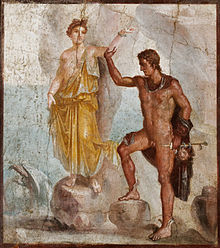
Back Andromeda (mitologie) Afrikaans أندروميدا (أسطورة) Arabic اندروميدا (ميثولوجيا) ARZ Andromeda (mifologiya) Azerbaijani Андромеда (мифология) Bashkir Андрамеда Byelorussian Андромеда (митология) Bulgarian অ্যানড্রোমিডা (পুরাণ) Bengali/Bangla Andromeda Breton Andromeda (mitologija) BS
| Andromeda | |
|---|---|
Princess of Aethiopia | |
 Perseus freeing Andromeda after killing Cetus, 1st century AD fresco from the Casa Dei Dioscuri, Pompeii | |
| Genealogy | |
| Born | |
| Parents | Cepheus and Cassiopeia |
| Consort | Perseus |
| Offspring | Perses, Heleus, Alcaeus, Sthenelus, Electryon, Mestor, Gorgophone |
In Greek mythology, Andromeda (/ænˈdrɒmɪdə/; Ancient Greek: Ἀνδρομέδα, romanized: Androméda or Ἀνδρομέδη, Andromédē) is the daughter of Cepheus, the king of Aethiopia, and his wife, Cassiopeia. When Cassiopeia boasts that she (or Andromeda) is more beautiful than the Nereids, Poseidon sends the sea monster Cetus to ravage the coast of Aethiopia as divine punishment. Queen Cassiopeia understands that chaining Andromeda to a rock as a human sacrifice is what will appease Poseidon. Perseus finds her as he is coming back from his quest to decapitate Medusa, and brings her back to Greece to marry her and let her reign as his queen. With the head of Medusa, Perseus petrifies Cetus to stop it from terrorizing the coast any longer.
As a subject, Andromeda has been popular in art since classical antiquity; rescued by a Greek hero, Andromeda's narration is considered the forerunner to the "princess and dragon" motif. From the Renaissance, interest revived in the original story, typically as derived from Ovid's Metamorphoses. The story has appeared many times in such diverse media as plays, poetry, novels, operas, classical and popular music, film, and paintings. A significant part of the northern sky contains several constellations named after the story's figures; in particular, the constellation Andromeda is named after her.
The Andromeda tradition, from classical antiquity onwards, has incorporated elements of other stories, including Saint George and the Dragon, introducing a horse for the hero, and the tale of Pegasus, Bellerophon's winged horse.[1] Ludovico Ariosto's epic poem Orlando Furioso, which tells a similar story, has introduced further confusion.[2] The tradition has been criticized for depicting the princess of Aethiopia as a white woman; few artists have chosen to portray her as dark-skinned, despite Ovid's account of her.[3] Others have noted that Perseus's liberation of Andromeda was a popular choice of subject among male artists, reinforcing a narrative of male superiority with its powerful male hero and its submissive female in bondage.[4][5]
- ^ Cite error: The named reference
Whatley 2004was invoked but never defined (see the help page). - ^ Cite error: The named reference
National Gallerywas invoked but never defined (see the help page). - ^ Cite error: The named reference
Ekall 2021was invoked but never defined (see the help page). - ^ Cite error: The named reference
Munich 1989was invoked but never defined (see the help page). - ^ Cite error: The named reference
Knutson 1992was invoked but never defined (see the help page).